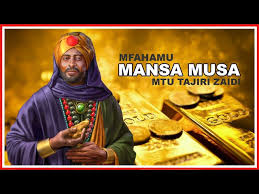
The Mali Empire (c. 1235–1600) was one of the greatest West African empires, known for its wealth, strong leadership, and influence on trade, culture, and education.
The Mali Empire (c. 1235–1600) rose to power due to several key factors:
1. Strategic Location & Trade – Mali was located along trans-Saharan trade routes, allowing it to control and profit from the trade of gold, salt, and other goods. Towns like Timbuktu and Gao became major commercial centers.
2. Strong Leadership – Leaders like Sundiata Keita (the founder) and Mansa Musa expanded the empire and strengthened governance. Mansa Musa's pilgrimage to Mecca (1324) showcased Mali’s wealth and influence globally.
3. Military Strength – Mali had a strong and well-organized army that helped conquer neighboring territories, including Ghana, and defend its wealth.
4. Agriculture & Natural Resources – Fertile lands along the Niger River supported farming, boosting food security and population growth. Gold mines in Bambuk and Bure provided immense wealth.
5. Islamic Influence & Education – Mali became a center of Islamic learning, with institutions like the University of Sankore in Timbuktu. Islam also facilitated trade and diplomacy with North Africa and the Middle East.
6. Efficient Administration – The empire had a well-structured government with provinces ruled by governors. Local chiefs paid tribute to the central authority, maintaining stability.
These factors combined to make Mali one of the wealthiest and most powerful empires in African history.
The Mali Empire had significant effects on West Africa and beyond, influencing trade, culture, education, and governance. Here are some of the key effects:
1. Economic Impact
i.Expansion of Trade: Mali controlled the trans-Saharan trade routes, making it a hub for gold, salt, ivory, and slaves. This boosted the regional economy and connected West Africa to North Africa and the Middle East.
ii.Wealth & Prosperity: The empire’s vast gold reserves made it one of the richest civilizations of its time. Cities like Timbuktu, Djenné, and Gao flourished as economic centers.
iii.Introduction of Currency: The use of gold dust and cowrie shells as currency helped standardize trade across the empire.
2. Cultural & Religious Influence
i.Spread of Islam: Islam became more widespread, influencing governance, education, and daily life. Many rulers, including Mansa Musa, promoted Islamic scholarship and built mosques.
ii.Blend of Traditions: While Islam spread, many indigenous African traditions and beliefs were preserved, leading to a unique cultural fusion.
iii.Influence on Art & Architecture: The construction of mosques and learning centers, such as the Great Mosque of Djenné, showcased Mali’s artistic and architectural achievements.
3. Educational & Intellectual Advancements
i.Growth of Learning Centers: Timbuktu became a major center of Islamic learning, attracting scholars from Africa and the Middle East.
ii.Establishment of Universities: Institutions like the University of Sankore preserved and advanced knowledge in subjects such as mathematics, astronomy, and law.
iii.Promotion of Literacy: The use of Arabic for religious and administrative purposes encouraged literacy among the elite.
.png)

.jpeg)





0 Comments: